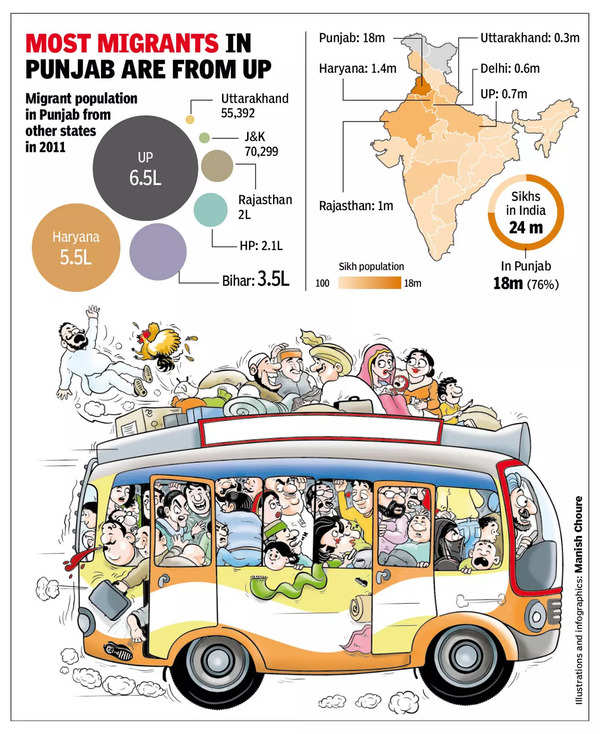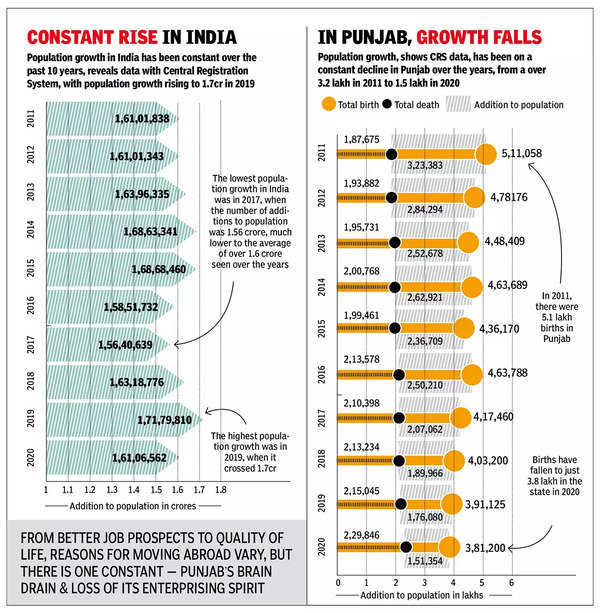Punjabis have been migrating to other countries for more than a century now. Initially, this trend was mainly centred around the state’s Doaba region due to smaller landholdings there. It was later propelled three decades ago by the turmoil in Punjab.Then, at the turn of this century, economic aspirations of the younger generation provided the boost. In the last few years, however, emigration has become such a phenomenon that it is now a part of the political discourse, and the issue even figured during the 2022 assembly elections and the recent Jalandhar parliamentary seat byelection.

Migrant population in Punjab from other statesin 2011
In the last decade or so, study visas from Western nations led to high levels of emigration by students, so much so that even the then Congress government in January 2022 announced steps for IELTS coaching to facilitate students.
After coming to power, chief minister Bhagwant Mann claimed that his AAP government would achieve reverse migration by generating job opportunities.But, a year and a half later, Mann’s NRI affairs minister, Kuldeep Singh Dhaliwal, argued that IELTS should be made part of the education system in Punjab to tackle the problem of centres facilitating unauthorised emigration.With the trend picking up in Punjab, there has been a major shift in the social, economic, and religious profiles of those emigrating in the last few years. Earlier, mainly people from rural Punjab and largely agrarian communities, especially Jat Sikhs, were rushing abroad.
In the last few years, it has picked up in urban areas, including among urban Sikhs and upper-caste Hindus. In Scheduled Caste communities too, the trend is picking up in the better off sections among them.
Trend is now spreading to Punjabis in other states also. If earlier men would emigrate, young women are now also in the same league.
NOT JUST A MATTER OF BRAIN DRAIN
Young Punjabis with backgrounds in trade, farming, and businesses, both small and established, are leaving for foreign countries in good numbers. Now, it is not just brain drain but a huge loss of enterprising spirit as well.
Queries from visa consultants and anecdotal instances clearly reflect the shift in the social and economic profile of emigration.
The reasons vary from better prospects for children and better social and personal security, to law and order, and general issues of governance. However, most migrating Punjabis are just following the trend. “The shift is definitely there from rural to urban, from agrarian communities to business communities, from those seeking employment to those already well off with established businesses, from higher officials in the police hierarchy to the lower ranks,” said Kuljeet Singh Hayer, president of Punjab Travel Agents Association.
“We have been receiving clients from rich families with established businesses whose kids wish to study and settle abroad. Their main reasons are quality of life and general safety,” he said. “The trend of remit-tances from abroad by the NRIs has reversed to a massive flight of finances from the state to other countries, and it would impact the economy of Punjab very severely in the coming years,” Hayer added.

Population growth in India has been constant over the past 10 years, reveals data with Central Registration System, with population growth rising to 1.7cr in 2019. Population growth, shows CRS data, has been on a constant decline in Punjab over the years, from a over 3.2 lakh in 2011 to 1.5 lakh in 2020
As the social and economic profile of migrants from Punjab changes, so have their reasons for leaving the country.
Jalandhar resident Karan Sehgal had an established business, but he emigrated to Canada with his family last year. “My biggest reason was the future of my kid,” he quipped.
“In the street where I lived, there were 13 houses, and seven families have migrated partially or completely on a permanent basis. A friend of mine came here on a business visa, and now he runs a restaurant and a hotel in Canada. Otherwise, he would have invested his money in Jalandhar. Another friend, who was doing brisk business and did not have any shortage of money in Punjab, moved to Toronto. In our cases, these were not employment issues or financial adversities; better quality of life and the future of kids worked for us,” Sehgal said.
“In Canada, I have also seen several Punjabis from Delhi,” he added. Jaspal Singh, who runs a successful business in the main market of Phagwara, revealed that his only son had moved to Canada nine months ago after his wife got a Canadian study visa, even as their business here had significantly increased. “Therewere no economic reasons for going abroad. None of us is happy now,” he said, adding that the children of many successful business families in Phagwara town had moved abroad.
Manjit Singh, who owns Chinook Canada Immigration Services in Ludhiana and has been catering to clients from Punjab and other states for 14 years, held that there had been a major shift in the economic, social, and professional profiles in the last few years. “Earlier, well-settled professionals would not go, but now they are also leaving the country after Canada brought changes in its immigration system in 2015.
I know of families that are in a dilemma about the future of their well-established businesses here as their children are not ready to live in Punjab. The most common refrain I hear from well-off families is, ‘We don’t see a future here.’ But it seems that many are simply following the trend, and it is also a case of peer pressure. Students are perhaps becoming victims of a complex when moving abroad is also seen as a success in itself and a sure formula for economic progress,” he said.
“The shift is from rural to urban; from lower economic strata to upper; from agrarian to business; from Punjab to Punjabis in other states, especially in western UP,Haryana, and Delhi,” added Manjit.
Amarjot Singh, who runs Southall Career Consultant in Jalandhar, said most of his clients were from urban areas, including business families. “Earlier, those running retail outlets, factories, or other businesses were not keen on sending their kids abroad, but now they were also following the trend.
The main reason is to settle abroad. The emigration bug has bitten urban people in a big way,” he said. For students, a study visa is a coveted document. “In our Class XII batch of 2021, 50% students from science and commerce streams at Apeejay School, Jalandhar, have already gone abroad.
The highest ratio was among commerce students,” said Jalandhar resident Kabir Singh, now pursuing his studies at Guru Nanak Dev University in Amritsar. “Earlier, rural versus urban ratio in emigration was around 90:10; now it is estimated at 65:35,” said Sukant Trivedi, who owns Trivedi Overseas Education Services in Jalandhar.
“In urban areas, maximum desperation is among small traders or shopkeepers, and I saw the rise of this tendency in this section after demonetisation and then the imposition of GST. In urban communities, the highest emigration trend appears to be prevailing among Khatris and Aroras, and Brahminsand Baniyas are also following suit,” he said.
Phagwara resident Pawan Duggal revealed that in the last four-five years, most of his relatives, especially younger ones, had moved abroad. “My mother’s two sisters with their entire families, one son each of her three brothers, and my son have gone to Canada in this time span,” he said, adding: “In another relative’s family, four brothers own two pipe-fitting factories in Jalandhar, but of their seven children, five have already moved to New Zealand.”
Ajay Goel, who runs Immigration Point in Jalandhar, revealed that the Baniya community also picked up the trend in the last four years. “Their planning is careful, unlike other cases where people mortgage or sell off properties to send kids abroad. They also choose their institutes and courses carefully,” he said.
Amritsar-based businessman Ramesh Bansal also endorsed the idea, saying that though the Baniya community was the last to join the trend, emigration was picking up among them. “Business people who are sending their children abroad are not striving for growth here at all. I am aware of examples where people are even shrinking their businesses. Along with brain drain, it is also a case of loss of enterprising spirit across communities, apart from outflows of finance,” said Bansal.
PICKING UP AMONG SCS TOO
Among SCs, Ramdasia/Ravidasia/Ad-dharmis and Mazhabi Sikhs/Balmikis are the largest communities in Punjab. The former is better off as compared to latter and is witnessing similar migration trend as in upper castes. “Those better off in Ravidsasia community are preferring to send their kids abroad. A similar tendency is showing in other castes and communities too,” said Adampur MLA Sukhwinder Singh Kotli, who is from the same community. Darshan Ratan Ravan, founder and head of Adi Dharam Samaj, a major organisation of Balmikis, said, “Trend in Balmikis is also picking up, but it is much less as compared to other communities as a majority chunk of our community is far less privileged than others, socially and economically.”
FAMILIES FROM UP, SETTLED IN PUNJAB TOO ASPIRE TO BE NRIS
Following Punjabis, migrants from other states who have settled in Punjab and have economically moved upwards, have also started following the trend. Kapil Dev, originally hailing from Deoria in UP, who came to work in Punjab 28 years ago and became a woodworker and construction contractor, said he had sent his eldest daughter to Canada, after she passed Class XII. “I saw many people sending their kids abroad. Besides, there are not many job avenues here and even most of the engineers don’t get more than Rs 15,000 per month. I thought she would have better prospects in Canada,” he said. “Trend is picking up in families from other states which are settled in Punjab. Four-five of my friends have also sent their kids abroad,” said Kapil.
Gabbu Lal, originally hailing from Gorakhpur in UP and who came to Punjab in 1990, said he had sent his son and daughter abroad on study visas. “My son did BCA and stayed here for two years, but could not find a job with a decent salary. In 2018, he went to Canada on a student visa. A year later, my daughter, who is two years older than him and is a B Tech in computer sciences, also moved there for higher studies,” he said, arguing: “Our days were different. I built my own house here after working hard; kids too are read to work hard these days, but don’t have much hope while living here.”
HIMACHALIS, TOO, FLYING OUT
Many families from Himachal Pradesh, especially those which have been settled in Punjab for long, have started following the trend of moving abroad. BJP Jalandhar district president Sushil Sharma, whose family has roots in Himachal Pradesh and whose father settled in Jalandhar initially, confirmed that the trend was picking up. “Among them, it started from those living in Punjab; now, it has spread to
extended families and friends in HP,” he said. “Two nephews and a niece of mine have gone to Canada for higher education. There are more relatives and acquaintances who are planning to go abroad,” he added.
CALL FOR NEW LAW
Amid fears of demographic changes, Congress MLA Sukhpal Singh Khaira and leader of opposition Partap Singh Bajwa on January 23 called on Punjab assembly speaker, seeking to introduce a private member’s bill to restrict/ban purchase of agricultural land by non-Punjabis “to protect our identity and demographic balance” on the lines of Himachal Pradesh Act of 1972. “We never heard from the speaker on this,” said Khaira
INFLUX OF MUSLIMS TO ‘SAFER’ PUNJAB
According to 2011 Census, the highest number of migrants in Punjab are from Uttar Pradesh, followed by Haryana and Bihar. Himachal Pradesh and Rajasthan are other two states from where migrants in the state are in significant numbers. The number of migrants living in Punjab for 10-19 years and for 5-9 years were also in the same order.
Now, Punjab appears to be having a fresh, unusual influx of Muslim migrants from UP. “Muslim migration has increased from UP in a few years. In addition to them, lower middle-class traders and middle-class businessmen from the community are also migrating and establishing businesses here. It is mainly due to the atmosphere in UP. Community members feel Punjab is safer for them as it is communally stable. They are getting into diverse trades, businesses and professions,” said Mazhar Alam, district president of Jamaiat Ulma e Hind and president of Masjid Kuba, Khambra, Jalandhar. “Earlier, migrant workers would keep their families back in their homes, but now workers, self-employed, small and middle-level businessmen are settling here with their families,” said Alam, adding: “In the last five years, their population might have almost doubled.”
Corroborating the trend, Sarwar Gulam Sabba, who is president of Punjab unit of Islamic Welfare Society and is associated with quite a few other community organisations, said with the growing number of Muslims from UP in Punjab in the last few years, abandoned mosques had been reopened and new mosques had also been established. “Earlier, Muslim workers from other states were coming in routine; but, in the last few years, there has been an unusual increase in the migration of Muslims from UP due to the atmosphere there; they are permanently settling here,” Sabba added






